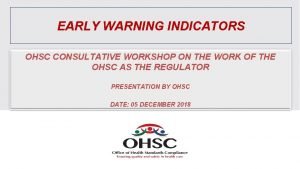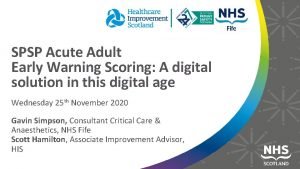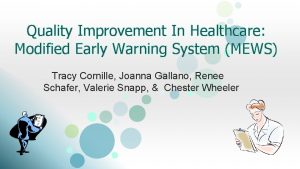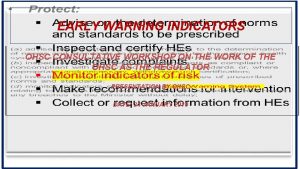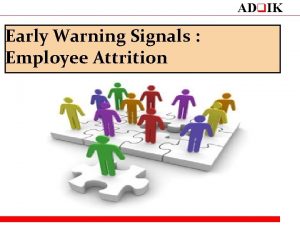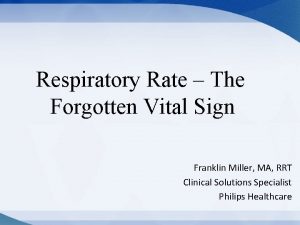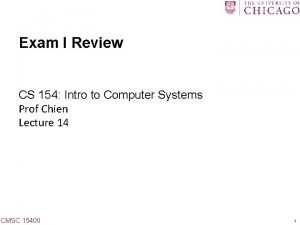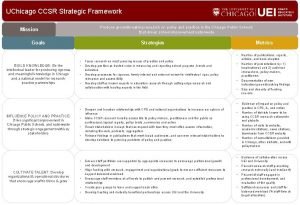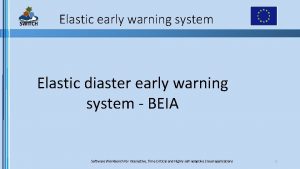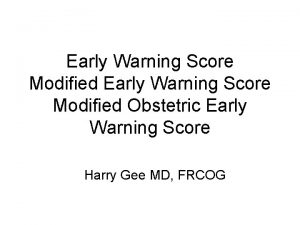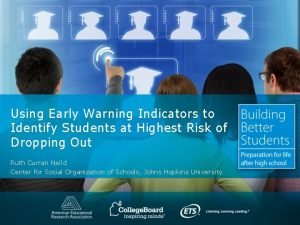CCSR ccsr uchicago edu Early Warning Indicators of



























- Slides: 27

© CCSR ccsr. uchicago. edu

Early Warning Indicators of High School Graduation and Dropout © CCSR Elaine Allensworth

Who will graduate? A number of students’ background characteristics have been associated with dropping out… © CCSR • Gender • Race

Who will graduate? A number of students’ background characteristics have been associated with dropping out… © CCSR • Gender • Race • Poverty • Test scores • Mobility • Over-age for grade • Special education status • ELL status in high school

Background factors are related to graduation, but don’t provide a good prediction of who will graduate Indicator of Future Graduation/Dropout… © CCSR Eighth grade test scores Race/ethnicity Economic status Gender Neighborhood poverty Mobility prior to high school Over-age for grade Prediction of graduates Prediction of Non-graduates 65% 48% correctly identified, using all background information

The “on-track” indicator A measure of progress during the first year of high school • An on-track student has accumulated five full course credits (in any subject) – The number required to move to 10 th grade in Chicago • An on-track student has no more than one semester F in a core subject © CCSR – English, math, science, or social studies

On-track by itself is a better predictor of graduation than background characteristics and test scores combined Indicator of Future Graduation/Dropout… Eighth grade test scores Race/ethnicity Economic status Gender Neighborhood poverty Mobility prior to high school Over-age for grade © CCSR On-track in 9 th grade Prediction of graduates Prediction of Non-graduates 65% 48% correctly identified, using all background information 80% 72% correctly identified, using only the on-track indicator

Background characteristics are related to graduation through course performance – not independently predictive Indicator of Future Graduation/Dropout… Eighth grade test scores Race/ethnicity Economic status Gender Neighborhood poverty Mobility prior to high school Over-age for grade © CCSR On-track in 9 th grade All of the above Prediction of graduates Prediction of Non-graduates 65% 48% correctly identified, using all background information 80% 72% correctly identified, using only the on-track indicator 81% 72%

On-track is highly related to graduation Four- and Five-Year Graduation Rates by Whether On-Track at the End of the Freshman Year Students entering high school in September 1999 100% 90% Percent graduated 80% 85% 81% 70% 60% 50% 40% 30% 28% 22% 10% *9 th graders who are on track are four times more likely to graduate than students who are off track 0% 4 -year graduation rate 5 -year graduation rate © CCSR On-track Off-track (Allensworth & Easton, 2005)

On-track is a better indicator than test scores Four-Year Graduation Rates by On-Track Status after Freshman Year and Incoming Reading and Mathematics Achievement Students entering high school in September 2000 100% 90% Percent graduated 80% 70% 82% 76% 68% 60% 50% 37% 40% 30% 20% 14% 26% 21% 10% 0% © CCSR Bottom: 42% on-track Second: Third: 54% on-track 65% on-track Eighth-Grade Achievement, in Quartiles On-track Off-track Top: 78% on-track (Allensworth & Easton, 2005)

Graduation and Freshman On-Track Rates 70 Percent of Students 60 50 40 Graduation 30 20 On-track © CCSR 10 0 1992 1993 1994 1995 1996 1997 1998 1999 2000 2001 2002 2003 2004 Fall of Freshman Year

Ninth grade absences, Fs and GPA are all strong predictors of eventual graduation © CCSR Indicator of Future Graduation/Dropout… Prediction of of graduates in non 4 years graduates Eighth grade test scores, mobility, overage, race, economic status, gender 65% 48% On-track in 9 th grade 80% 72% 9 th Grade GPA 80% 73% 9 th Grade Course Failures 80% 66% 9 th Grade Absences 77% 59%

Freshman Year Grades & Failures Can Precisely Identify Students’ Risk of Not Graduating Virtually all students with a “B” average or higher in their first year will graduate in 4 years © CCSR Virtually all students with less than a “D” average in their first year will fail to graduate Students with D+/C- GPAs could go either way

© CCSR Freshman Year Grades & Failures Can Precisely Identify Students’ Risk of Not Graduating

© CCSR Freshman Year Grades & Failures Can Precisely Identify Students’ Risk of Not Graduating

Ninth Grade indicators predict graduation in similar ways for Students with Disabilities But SWDs are less likely to graduate because are at low end of on-track and off-track groups © CCSR Five-Year Graduation Rates by 9 th Grade On-Track Status

Students with Disabilities are Less Likely to Be On-Track in 9 th Grade • Differences are largely a result of high absence rates among SWD © CCSR • Students with learning disabilities and mild cognitive impairment also benefit less from time spent studying

Ninth Grade Indicators also Predictive for English Language Learners But differences in graduation rates persist 100% Four-Year Graduation Rates 90% 84% 80% 74% 76% 81% 87% 70% 60% Off-Track 50% 40% 30% 26% 21% 28% 20% 31% On-Track 25% 10% 0% © CCSR CPS District New ELL Long-Term Recently Long-Term Never ELL Average ELL Proficient Bars in red only reflect Hispanic students in CPS.

What explains differences in graduation rates between 9 th grade ELL and long-term proficient Hispanic students? § High School they attended § Age began high school – for ELLs who were newcomers to CPS in the middle grades or later § Special education status, absences - for students who had been ELLs since the primary grades © CCSR § Educational aspirations

In 2008 Chicago Public Schools created a realtime data system around ninth grade indicators • Data reports help schools monitor and support students • CPS runs “On-Track Labs” to develop practices around the reports • CCSR produces research flyers for parents and teachers, district distributes to all © CCSR • In 2009, schools in the Network for College Success begin using strategy reports

CPS Early Warning Reporting System: ‘Hot’ Data Supporting Data-Driven Leadership Development Freshmen Watchlist • List of incoming firsttime freshmen with risk factors • Populated with 8 th grade data, including grades, attendance, EXPLORE scores, whether the student has an IEP, and feeder elementary school © CCSR ü Use in the summer and through the first quarter Freshmen Success Report • On-going monitoring of all first-time freshmen • Report tracks increases in risky behaviors (high absences, low course grades, high course failures) ü Use after the first quarter throughout the year for firsttime freshmen Credit Recovery Report • List of all students who fall into the credit recovery target population ü This report will be updated at the end of each semester and should be used to enroll students in credit recovery programs

© CCSR Snapshot of the CPS Freshmen Watchlist

© CCSR CPS Guide for Using Data Reports

Identifying systematic success and challenges © CCSR SUMMARY REPORTS FOR EVALUATING PRACTICES

© CCSR Reports Show How School Practices Affect Students

On-track rates improved when schools had tools that made it easy to use validated indicators 75, 0% On track in CPS accountability system What matters report 70, 0% 67, 8% District On. Track 65, 0% Rates 64, 4% 61, 8% 59, 2% 59, 5% 59, 0% 59, 5% 58, 9% 60, 0% 56, 8% 55, 0% 72, 7% 57, 3% Student tracking systems and school data reports © CCSR 50, 0% Spring Spring Spring 2001 2002 2003 2004 2005 2006 2007 2008 2009 2010 2011

Three ways the research and indicator reports help schools to better address graduation § They focus conversations and effort among staff, parents and students on actionable problems that really matter for graduation § They identify the right students for support - Make sure students don’t fall through the cracks © CCSR § They identify patterns in student performance so schools can address problems strategically
 Ohsc
Ohsc Nec3 early warning
Nec3 early warning Early warning
Early warning Early warning intervention and monitoring system
Early warning intervention and monitoring system Earthquake early warning systems
Earthquake early warning systems Earthquake early warning systems
Earthquake early warning systems Fife early warning score
Fife early warning score Early obstetric warning system chart
Early obstetric warning system chart Early warning system in disaster management
Early warning system in disaster management National early warning signs
National early warning signs Pews score
Pews score Mews score chart
Mews score chart Early warning score
Early warning score Ohsc early warning system
Ohsc early warning system Sri lanka tsunami warning system
Sri lanka tsunami warning system Breast structure
Breast structure Early warning attrition tracker excel
Early warning attrition tracker excel Icews
Icews Early warning score
Early warning score Uchicago consortium on school research
Uchicago consortium on school research Nmap script
Nmap script Uchicago ccrf
Uchicago ccrf Henry frisch uchicago
Henry frisch uchicago Buysite uchicago
Buysite uchicago David schuster uchicago
David schuster uchicago Uchicago cs 154
Uchicago cs 154 Flash uchicago
Flash uchicago Uchicago globus
Uchicago globus
